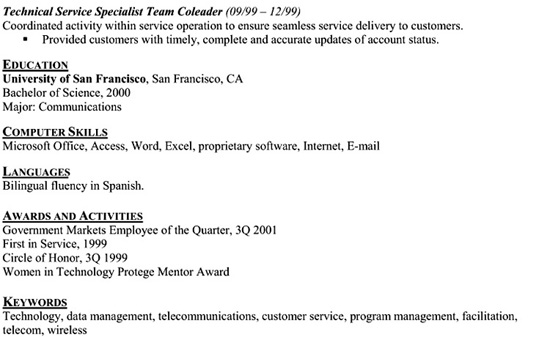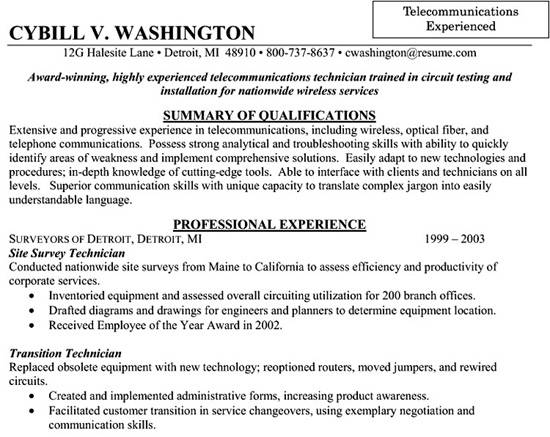The Resume.Com Guide to Writing Unbeatable Resumes (28 page)
Read The Resume.Com Guide to Writing Unbeatable Resumes Online
Authors: Warren Simons,Rose Curtis






The Information Technology Resume
The Information Technology (IT) resume is a highly specialized document that is quite different from the other resumes we’ve discussed. The IT resume uses specific technical language as its driving force, showing hirers how you can meet the needs of today’s changing marketplace.
The IT industry has undergone radical changes over the last 20 years. From the beginning of widespread computer use by consumers in the 1980s to the dot-com craze in the late 1990s and beyond, IT has affected every aspect of the marketplace. More than ever employers are turning to IT specialists to help them automate positions, secure internal operations, streamline workflow processes, and maximize employees’ productivity by training staff members on proprietary software.
Unfortunately, the end of the 1990s witnessed massive layoffs in the technical sector, with the telecommunications industry perhaps being the most heavily affected. As the competition among IT professionals is especially fierce, partly as a result of layoffs and partly because of an increasing level of qualified candidates in the marketplace, the need for a professional resume has become essential.
The IT field is extremely diverse and vast, with specializations ranging from help-desk support and Web site design to network administration and coding.
Perhaps more than is the case in any other industry, IT’s complexity and variety of positions makes resume writing a process that needs to be clear and efficient. IT professionals need to know what hiring managers are looking for in their unique resumes. This chapter is intended to help technical professionals create attractive, effective documents that stand out from the competition.
Hiring managers are looking for IT professionals who have extensive technical skills as well as demonstrable people skills. A common mistake IT professionals make is to underestimate the importance of noncomputer skills such as the ability to communicate effectively and collaborate with coworkers at all levels. The key to creating a successful IT resume is highlighting today’s in-demand skills and understanding the needs of the marketplace. Including both hard skills and soft skills allows you to position yourself as a strong candidate, and building a twenty-first-century IT resume is the first step in this process.
All successful resumes will sell your strongest skills and achievements within 10 seconds, and the IT resume is no different. Your strongest selling points must be organized clearly in the right format for a hirer to identify your talents and traits. There are few rules governing the correct format to use.
Use the chronological format if you
■
Have had progressively responsible positions and promotions
■
Are applying for jobs similar to your current or last job
Use the functional format if you
■
Have multiple employment gaps in your work history
■
Are a recent college graduate with no paid work experience
■
Are switching industries or careers
Use the combination format if you
■
Have extensive work experience as a consultant
■
Can better display your project management experience in this style
To view different formats and styles, see Chapter 6.
Choosing the best format is the foundation of creating a professional resume. The next seven steps will guide you in selecting and organizing your strongest selling points to develop a winning resume.
The header is the first section at the top of a resume, and it contains your name, address, phone number, and e-mail address. You also can include your
cell phone, fax, or pager number in this section, but that information is optional. You can list one or two relevant certifications next to your name to highlight valuable certifications in your area of expertise, but make sure those certifications support your professional goal; if they do not, personalize each resume according to the position you are applying for or just list your certifications and degrees in the appropriate section on the resume. For example, if you are a systems engineer, your name may be presented as “John Doe, MCSE.”
Separate your name from your contact information with a solid line, as we discussed in Chapter 6. Each component of your contact information should be separated with a symbol. For example, your header may look like this:

Double- and triple-check that your contact information is spelled correctly. If your e-mail address is incorrect, a prospective employer will not spend time and energy tracking you down no matter how skilled you appear on paper.
For additional tips on creating effective headers, refer to Chapter 6.
A headline sells your greatest assets in one to two sentences. It appears at the top of the resume, just below the header, and acts as the main advertisement for what you can offer an employer. This can include years of experience, awards, certifications, and technical expertise and is usually the first area a prospective employer will examine when reviewing your resume. It’s here where you have to hook them and motivate them to keep reading.
➢
A highly analytical, certified network administrator with eight years of expertise and extensive skills in QA, technical support, and systems repair
➢
Creative, motivated Java programmer with five-year proven track record developing cutting-edge programs for dynamic software products
➢
Dedicated technical support specialist with solid background in troubleshooting systems, updating networks, and providing on- and off-site support for over 500 end users
A great way to start a headline is to begin with an adjective modifying your professional objective or job title:

Next, you can add your strongest selling points, including years of experience or relevant certifications:
